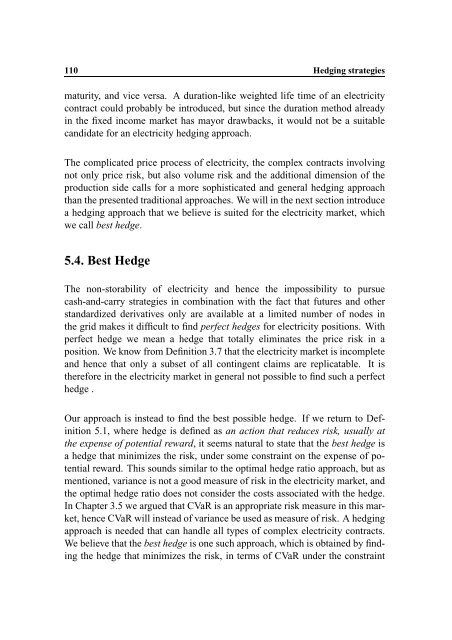Hedging Strategy and Electricity Contract Engineering - IFOR
Hedging Strategy and Electricity Contract Engineering - IFOR
Hedging Strategy and Electricity Contract Engineering - IFOR
You also want an ePaper? Increase the reach of your titles
YUMPU automatically turns print PDFs into web optimized ePapers that Google loves.
110 <strong>Hedging</strong> strategies<br />
maturity, <strong>and</strong> vice versa. A duration-like weighted life time of an electricity<br />
contract could probably be introduced, but since the duration method already<br />
in the fixed income market has mayor drawbacks, it would not be a suitable<br />
c<strong>and</strong>idate for an electricity hedging approach.<br />
The complicated price process of electricity, the complex contracts involving<br />
not only price risk, but also volume risk <strong>and</strong> the additional dimension of the<br />
production side calls for a more sophisticated <strong>and</strong> general hedging approach<br />
than the presented traditional approaches. We will in the next section introduce<br />
a hedging approach that we believe is suited for the electricity market, which<br />
we call best hedge.<br />
5.4. Best Hedge<br />
The non-storability of electricity <strong>and</strong> hence the impossibility to pursue<br />
cash-<strong>and</strong>-carry strategies in combination with the fact that futures <strong>and</strong> other<br />
st<strong>and</strong>ardized derivatives only are available at a limited number of nodes in<br />
the grid makes it difficult to find perfect hedges for electricity positions. With<br />
perfect hedge we mean a hedge that totally eliminates the price risk in a<br />
position. We know from Definition 3.7 that the electricity market is incomplete<br />
<strong>and</strong> hence that only a subset of all contingent claims are replicatable. It is<br />
therefore in the electricity market in general not possible to find such a perfect<br />
hedge .<br />
Our approach is instead to find the best possible hedge. If we return to Definition<br />
5.1, where hedge is defined as an action that reduces risk, usually at<br />
the expense of potential reward, it seems natural to state that the best hedge is<br />
a hedge that minimizes the risk, under some constraint on the expense of potential<br />
reward. This sounds similar to the optimal hedge ratio approach, but as<br />
mentioned, variance is not a good measure of risk in the electricity market, <strong>and</strong><br />
the optimal hedge ratio does not consider the costs associated with the hedge.<br />
In Chapter 3.5 we argued that CVaR is an appropriate risk measure in this market,<br />
hence CVaR will instead of variance be used as measure of risk. A hedging<br />
approach is needed that can h<strong>and</strong>le all types of complex electricity contracts.<br />
We believe that the best hedge is one such approach, which is obtained by finding<br />
the hedge that minimizes the risk, in terms of CVaR under the constraint
















